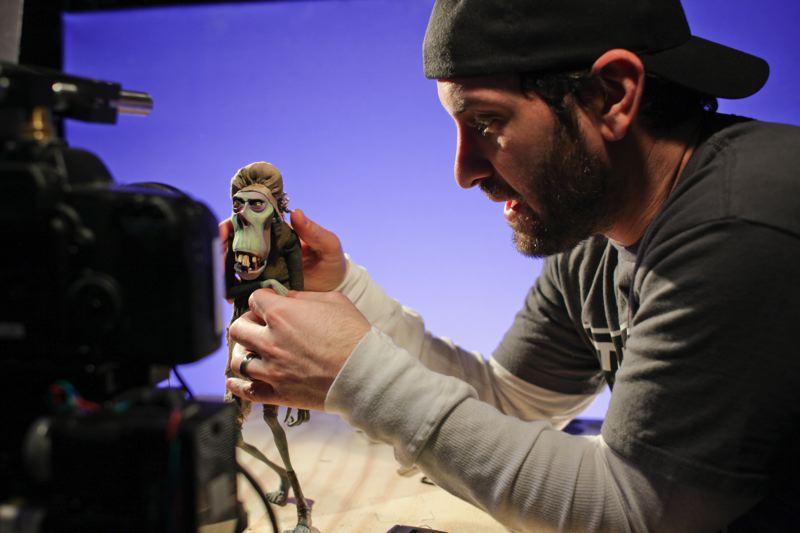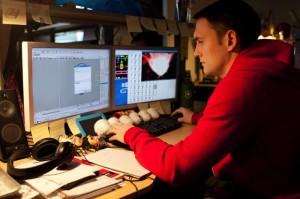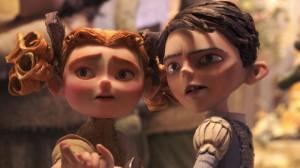Stop motion animation is only as new as film. However, it has changed dramatically since its first days. The 1897 film The Humpty Dumpty Circus featured a toy circus made possible by moving the various characters for each shot. Contemporary stop motion filming has grown exponentially in sophistication and part of that is because of advances in technology. To Brian McLean, the man in charge of Laika’s 3D printing and prototyping department, the match between the demands of stop motion filming and 3D printing’s ability to mass produced individually customized, and highly precise, pieces was an absolutely perfect fit.
Laika currently houses nine 3D printers (the most expensive, a machine that can print both rubber and plastic, costs over $210,000) but they aren’t replacing the artists required for the creation of the films. Laika’s film ParaNorman required 25 artists and The Boxtrolls set employs 55. There are some things that the 3D printers cannot do. For example, the tiny dots on character’s freckled faces have to be placed by hand and cheek blushes must match from frame to frame. As McLean noted, “It’s a tool and you still need artists and technicians to run that tool and get the most out of it.”
Rather than eliminating the artist, the technology has changed the way they work, expanding it in some cases. After all, the creation of the pieces in the 3D modeling software is not simply a matter of technical data input. It is instead another medium in which to create – it is a tool with its own set of possibilities and limitations. McLean did not arrive at the use of these technologies through a tech background; in fact, he admits that he was somewhat intimidated by the machines when he first arrived.

Courtesy of Laika Inc/Focus Features – Brad Schiff, Animation Supervisor for ParaNorman, preps a zombie figure
Now he’s a 3D printing convert.
“3D printing is on the verge of revolutionizing everything we’ve ever designed as a human race.”
One thing he is particularly interested in is the way in which 3D printing can increase the nuance in characters faces. The film The Nightmare Before Christmas had an impressive 800 different heads for each character. However, many of those were transitional faces used to move between two different facial expressions, so 800 heads does not equal 800 expressions. Each second of these stop motion films requires between 12 and 24 individual shots, so you can imagine how quickly you run the gamut of all of the available expressions.
It takes days for each head to be hand sculpted and there is only so much of that process which can be sped up without sacrificing quality. It seemed that within the constraints of a film project’s timeline, nothing could be created that would ever match the variety and subtlety present in CGI animation. However, with the introduction and integration of 3D printing into the stop motion workflow, the limits were, if not wholly removed, at least pushed far away. The heroine of the 2009 movie Coraline had 207,000 different facial expressions. Only three years later, Norman from ParaNorman had 1.4 million different expressions.
Laika isn’t just riding the wave of 3D technology; it’s pushing the frontiers. According to Tom McLean (no relation to Brian), Laika’s 3D printer usage was important beyond the confines of the film industry. It represented the first time that mass production in any industry was performed using 3D printing. And its impact continues to reinforce the potential that this partnership creates. McLean expressed his impressions:
“The expressions on the faces, the quality of the skin, it looked more realistic than anything I’ve ever seen on stop-motion. They’re doing things that even the creators of these printers had not thought of.”
As with all breakthroughs, there has been a great deal of experimentation required on the part of artists and filmmakers in order to utilize the technology to its best advantage. The heads created with the 3D printers would have to be resilient enough for use and reuse (and more reuse) and have to withstand the hot studio lights without breaking down, through more than 18 months of shooting and storage. Information about humidity and temperature of the day of production has to be cataloged with each part so that conditions can be replicated for creating identical parts. All of this means that there are hundreds of thousands of body parts that can interchanged. This wouldn’t be possible without Laika’s puppet librarian to keep everything organized.
The characters being created for the upcoming film The Boxtrolls will have greater detail, shading, and even dirtier faces than ever before seen in stop motion, all because of continued advances in 3D printing – not just the technology, but also the artistry. McLean admits, “These characters will have more emotional range than I will ever have.”
I can’t wait to show my kids the movie and we’ll all be paying closer attention to the characters faces. Let’s hear your opinion on the use of 3D printing in stop motion filming in the stop motion 3d printing forum thread on 3DPB.com. Check out the trailer for Laika’s latest movie, The BoxTrolls.
Subscribe to Our Email Newsletter
Stay up-to-date on all the latest news from the 3D printing industry and receive information and offers from third party vendors.
You May Also Like
3D Printing News Briefs, April 27, 2024: Research, Digital Dentistry, Cycling, & More
We’re starting today’s 3D Printing News Briefs with some research into 3D printed luminescent quantum-dot polymer architectures and free-form laser beam shaping, and then on to an open source 4-axis...
HP & INDO-MIM Collaborate to Boost Metal 3D Printing in India
HP Inc. and INDO-MIM, a US- and India-based supplier of metal injection molding (MIM) powders and contract manufacturer, have announced that the two companies will collaborate to accelerate additive manufacturing...
3D Printing News Briefs, February 17, 2024: Shot Blasting, Service Bureaus, & More
In today’s 3D Printing News Briefs, we’re starting out with post-processing, as SKZ Würzburg is using a shot blast system from AM Solutions for its research. Moving on to business,...
3D Printing News Unpeeled: Not That Kind of Organ 3D Printing
GKN Aerospace will create a 150 jobs in Trollhattan Sweden with an investment of $60 million part of which comes from the Swedish Energy Agency’s Industriklivet initiative. The investment will...


































